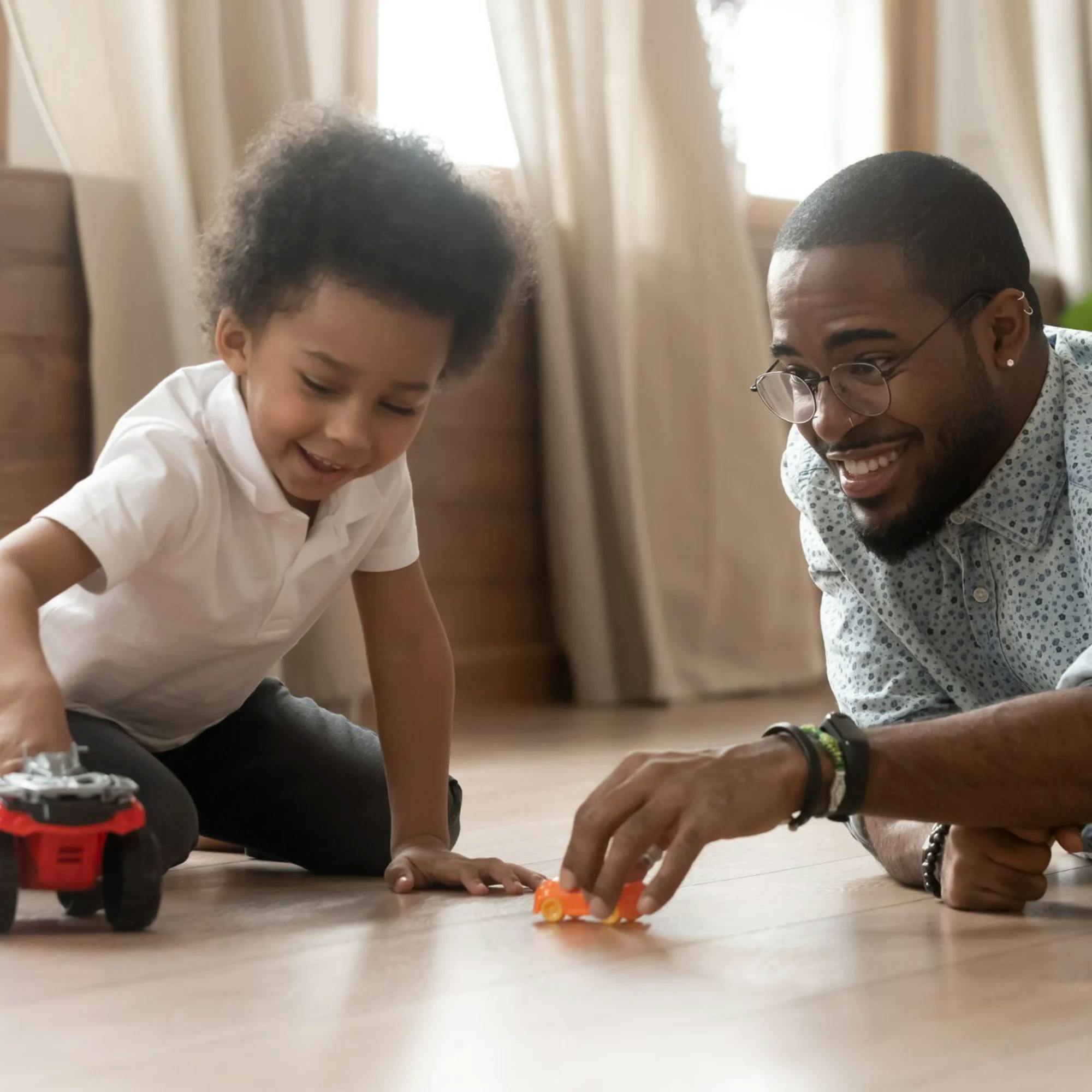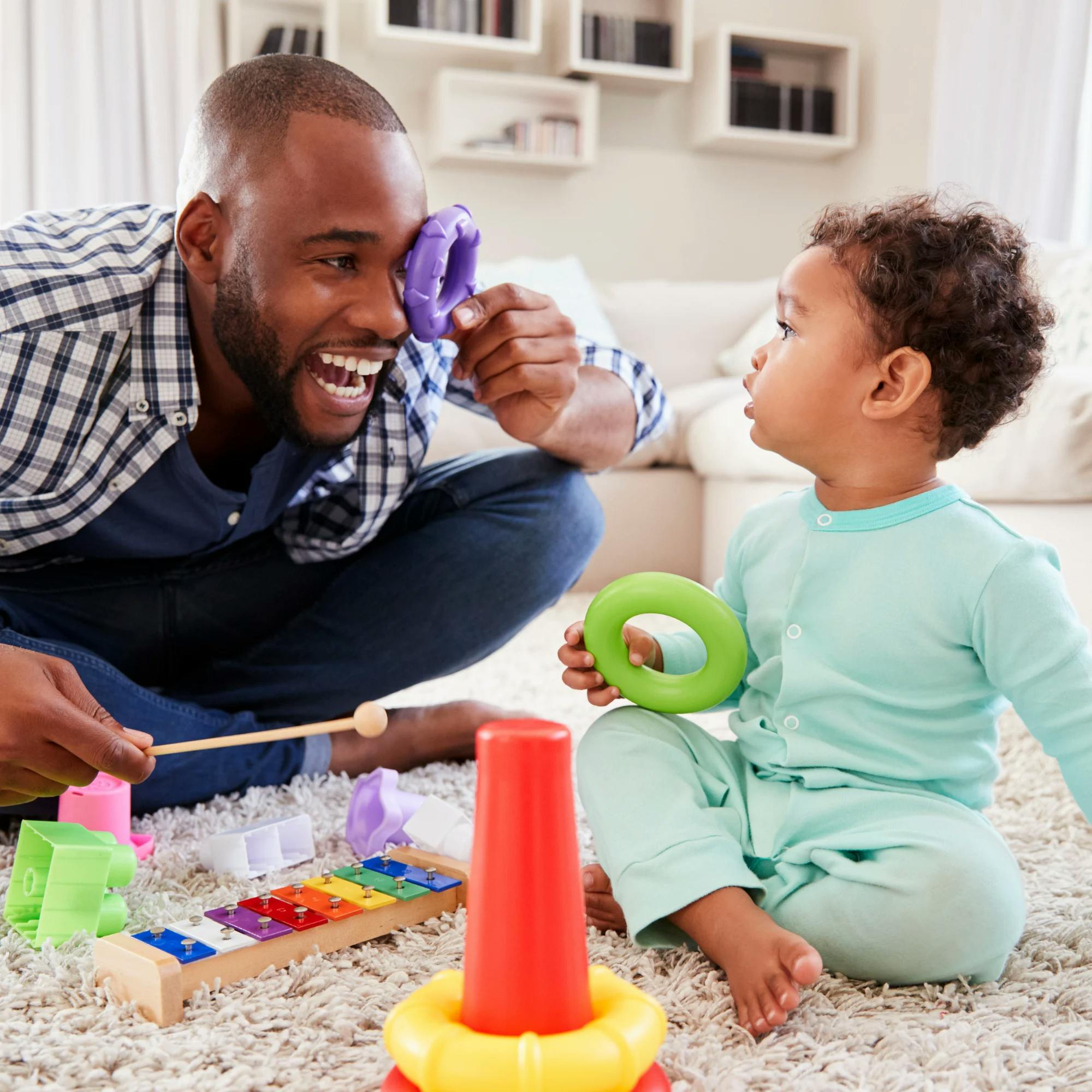If your child isn’t able to talk, it can be hard to understand what they need or how they feel. This can create a lot of frustration for everyone involved! But there are ways you can communicate and connect with your child, even if they’re nonverbal or have a speech delay. Just a few simple changes in your daily interactions can make a big difference. Read on to learn how.
Knowledge is power
Take 5 minutes to check your child’s speech milestones with our free online screener.
 Start the screener
Start the screenerDaily life with a speech-delayed child
Some everyday routines can be a challenge when your little one isn’t talking. Maybe they start crying and can’t tell you what’s wrong–are they hurt? Hungry? Tired? Sad? Or you can sense your toddler is frustrated, but you’re not sure why or what they need. The child wants to communicate, and the caregiver wants to understand, but neither person can figure out how to meet in the middle.
There can be a few reasons for a speech delay. The most common is an expressive language delay, but a receptive language delay may be a factor as well. Let’s discuss what these mean.
Understanding the 2 types of language delays
Expressive language refers to how a person communicates their thoughts, feelings, and ideas. We typically think about communication in terms of using words, but nonverbal language is communication, too! Pointing, gesturing, and using signs are all considered expressive language. Having an expressive language disorder makes it difficult for a child to express what they want, need, or feel.


Receptive language is what a person is able to understand of the words spoken to them. For example, if a parent says, “Stop!” or “Come here!,” the child has to understand the meaning of those words in order to respond appropriately. Children who are delayed in receptive language have trouble understanding conversation and knowing how to respond when someone tells them something. This can make communication even more difficult between child and caregiver.
Some children may only be delayed in one area: receptive or expressive language. But many times, children can have a mixed language delay, where they have problems with both receptive and expressive language.
5 ways to communicate with your delayed or nonverbal child
Communication doesn’t have to equal frustration. Here are 5 tips you can use at home to communicate with a child who isn’t talking or has a speech delay.
1 Use gestures and sign language
When speaking with your child, try communicating with gestures. You can use the gestures yourself and teach your child to use them as well.
If your child has trouble understanding what you’re saying, use gestures to match your words. For example:
If you say “Yes” or “No,” nod or shake your head as you give them your answer.
If you’re telling them “Come here!,” put your hands out to show them you want them to come.
If you need your child to pick up a toy, point to where you want them to put it as you give them the verbal direction.
All of these simple gestures can help your child see what they should do as they learn the words that go along with it. They may even begin using some gestures themselves! For example, when you’re trying to figure out what your child needs, you can say, “Show me,” and see if they will point to an item.
You can also try using sign language. Baby signs give children a way to communicate needs such as “more,” “eat,” and “help.” There is a lot that can be communicated by using a simple sign, and the benefits can be huge! Instead of crying in frustration because they’re hungry, your child could use a simple sign to tell you they want to eat.


2 Use pictures to help your child communicate
Using pictures can be very helpful for kids who are delayed in speech and language. Here’s how this works.
First, think about items your child may need to request, such as favorite foods, drinks, toys, and activities. Find images of these items online, or take pictures of them yourself.
Print out the pictures and choose a central spot to keep them, such as an envelope, folder, or binder. If you’re able to laminate the pictures, this will keep them in the best shape for the longest amount of time!
Now let’s look at two possible ways to use the pictures for communicating.
Say you and your child are going to the store, and you need to tell your child it’s time to go. You could show them a picture of shoes, to let them know it’s time to get their shoes on. Then show them a picture of the car and the store. This type of picture communication helps children better understand routines and what to expect for the day’s schedule.
When your child needs an item, you can prompt them to show you a picture of it.
Here’s another scenario. When your child needs an item, you can prompt them to show you a picture of it. This takes practice; you’ll likely need to show your child the pictures often and give them lots of help. Speech therapy can be a big support in this area. A speech therapist can help teach your child how to use pictures to express their wants and needs.
Some kiddos do very well with picture communication, even if it’s just temporarily before they begin to talk. This may not be how you imagined communicating with your child. But keep in mind how much a tool like this could improve your child’s everyday life!
3 Offer your child choices
One of the simplest changes you can make to help your child communicate is to use choices. Instead of asking open-ended questions they may not be able to answer, such as “What do you want to eat?,” give them choices. You can say, “Do you want an apple, or crackers?”
It’s even better if you can show your child the items. Hold them up one at a time so your child can see them presented, and then side by side. Chances are, your child will point or reach toward the one they want. If not, you can prompt them to make a gesture. If they’re learning to talk, you can model the word they should use: “apple” or “crackers.”


4 Ask your child yes/no questions
Again, with children who have a speech or language delay, it’s best not to use too many open-ended questions. In addition to offering choices, you can ask your child yes/no questions. They can respond by nodding or shaking their head, or perhaps saying the words “yes” or “no.”
With children who have a speech or language delay, it’s best not to use too many open-ended questions.
If your child gets hurt, you can ask, “Did you hurt your knee?” or “Did you fall down?,” rather than “What happened?” Asking questions your child can answer will not only help you both communicate better, but also make your child feel successful. This shows them that there are other ways they can communicate and helps strengthen those skills.
Find the right speech therapist for your child
We'll match you with a licensed speech therapist who's experienced in your child's needs and available when you are.
 Get started
Get started5 Try for single words or short phrases
When talking with your little one, make sure you set your expectations correctly. If your child isn’t talking yet, or they have only a few words, don’t try to help them use sentences. Focus on teaching them to use single words: “ball,” “milk.” If they can do that, work on short phrases: “more milk.” You can model examples of what your child could’ve said in that moment to help them learn appropriate responses.


Practice makes progress
It can take some time for children to begin to use other forms of communication. If you’re using one of these tips, keep at it. Your child may not pick it up immediately. Consistency is key. And remember to be patient. When you both learn how to communicate with each other, so many doors can open up!
Keep in mind, too, that you don’t have to go it alone. If you have any concerns at all about your child’s speech and language development, contact a speech therapist. They can perform an evaluation, determine if speech therapy is needed, and teach you how best to support your child as they grow. If your child needs therapy, the earlier they can start, the better!
How Expressable Can Help
Concerned your child isn't reaching age-expected milestones? Looking for communication support from a professional? Expressable is a national online speech therapy practice serving children and adults. We treat all major areas of communication and feeding, offer flexible hours including evenings and weekends, and accept most major health insurance plans. We’re proud to have earned more than 3,000 5-star reviews from our clients (4.9/5 average).
Our therapy model is centered on parent and caregiver involvement. Research proves that empowering caregivers to participate in their loved one’s therapy leads to better outcomes. That’s why we combine live, 1-on-1 speech therapy with personalized education and home practice activities for faster progress.
Communication is more than words. It’s how we share how we feel and show who we are. We’re here to help you or your child do just that.

 Abby Barnes, M.S., CCC-SLP
Abby Barnes, M.S., CCC-SLP










